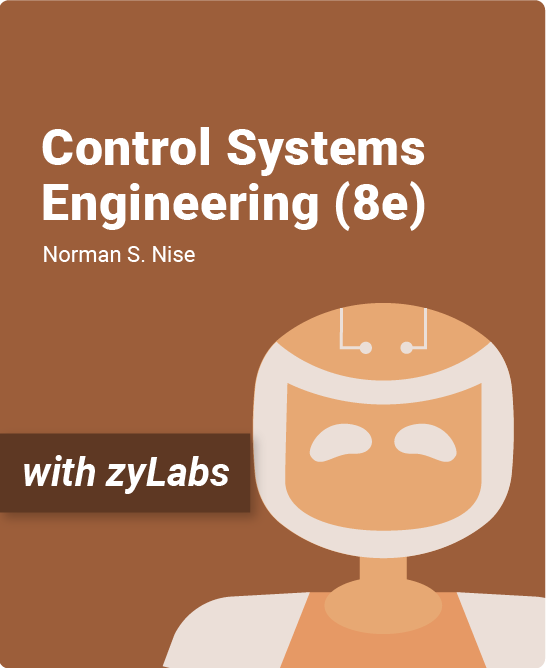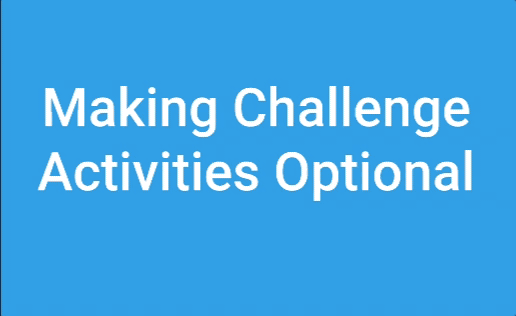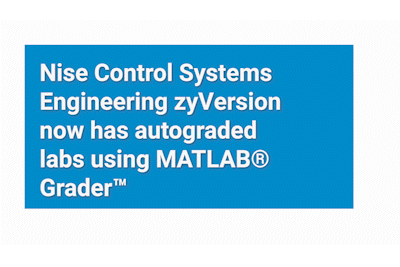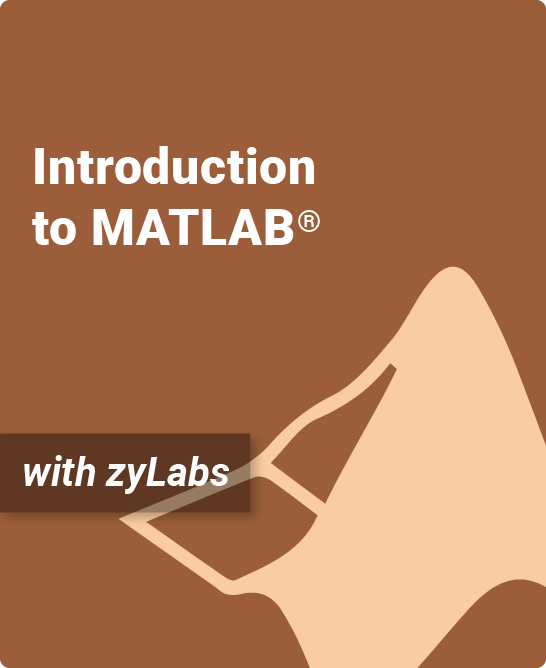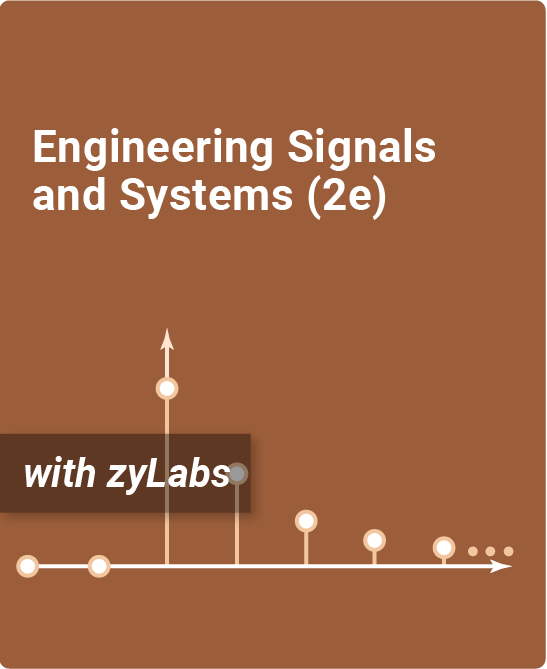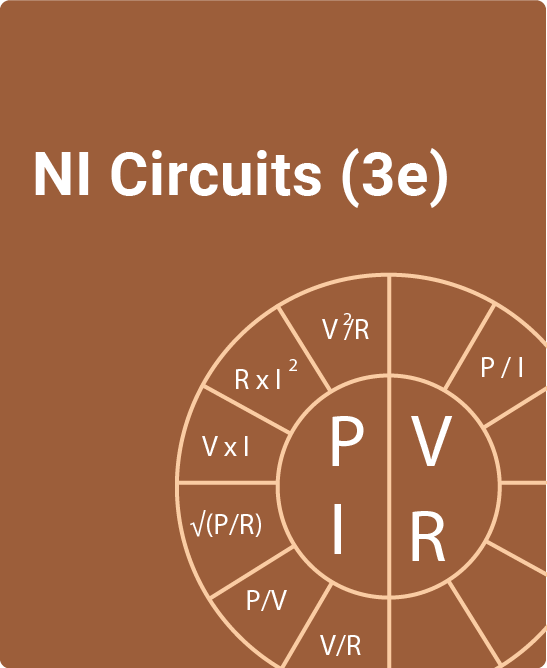Table of Contents
1. Introduction
1.1 Introduction
1.2 A history of control systems
1.3 System configurations
1.4 Analysis and design objectives
1.5 The design process
1.6 Computer-aided design
1.7 The control systems engineer
1.8 Summary
1.9 Review questions
1.10 Cyber exploration laboratory
1.11 Bibliography
1.12 Problems
1.13 LAB: Getting started with MATLAB Grader
2. Modeling in the Frequency Domain
2.1 Introduction
2.2 Laplace transform review
2.3 The transfer function
2.4 Electrical network transfer functions, Part 1
2.5 Electrical network transfer functions, Part 2
2.6 Translational mechanical system transfer functions
2.7 Rotational mechanical system transfer functions
2.8 Transfer functions for systems with gears
2.9 Electromechanical system transfer functions
2.10 Electric circuit analogs
2.11 Nonlinearities
2.12 Linearization
2.13 Summary
2.14 Review questions
2.15 Cyber exploration laboratory
2.16 Hardware interface laboratory
2.17 Bibliography
2.18 Problems
2.19 LAB: Partial fraction expansion and inverse Laplace transforms
2.20 LAB: Solving mesh equations with symbolic variables
3. Modeling in the Time Domain
3.1 Introduction
3.2 Some observations
3.3 The general state-space representation
3.4 Applying the state-space representation
3.5 Converting a transfer function to state space
3.6 Converting from state space to a transfer function
3.7 Linearization
3.8 Summary
3.9 Review questions
3.10 Cyber exploration laboratory
3.11 Bibliography
3.12 Problems
3.13 LAB: State space and transfer function representations of a two mass system
4. Time Response
4.1 Introduction
4.2 Poles, zeros, and system response
4.3 First-order systems
4.4 Second-order systems: introduction
4.5 The general second-order system
4.6 Underdamped second-order systems
4.7 System response with additional poles
4.8 System response with zeros
4.9 Effects of nonlinearities upon time response
4.10 Laplace transform solution of state equations
4.11 Time domain solution of state equations
4.12 Summary
4.13 Review questions
4.14 Cyber exploration laboratory
4.15 Hardware interface laboratory
4.16 Bibliography
4.17 Problems
4.18 LAB: First order response characteristics of an RC circuit
4.19 LAB: Second order response characteristics of a mass-spring-damper system
5. Reduction of Multiple Subsystems
5.1 Introduction
5.2 Block diagrams
5.3 Analysis and design of feedback systems
5.4 Signal-flow graphs
5.5 Mason’s rule
5.6 Signal-flow graphs of state equations
5.7 Alternative representations in state space
5.8 Similarity transformations
5.9 Summary
5.10 Review questions
5.11 Cyber exploration laboratory
5.12 Bibliography
5.13 Problems
5.14 LAB: Block diagram algebra and transient responses for higher order systems
5.15 LAB: State space models of a double mass-spring-damper system
6. Stability
6.1 Introduction
6.2 Routh-Hurwitz criterion
6.3 Routh-Hurwitz criterion: special cases
6.4 Routh-Hurwitz criterion: additional examples
6.5 Stability in state space
6.6 Summary
6.7 Review questions
6.8 Cyber exploration laboratory
6.9 Bibliography
6.10 Problems
6.11 LAB: Stability of a DC motor with position control
7. Steady-State Errors
7.1 Introduction
7.2 Steady-state error for unity-feedback systems
7.3 Static error constants and system type
7.4 Steady-state error specifications
7.5 Steady-state error for disturbances
7.6 Steady-state error for nonunity-feedback systems
7.7 Sensitivity
7.8 Steady-state error for systems in state space
7.9 Summary
7.10 Review questions
7.11 Cyber exploration laboratory
7.12 Bibliography
7.13 Problems
7.14 LAB: Steady-state analysis of a motor speed controller
8. Root Locus Techniques
8.1 Introduction
8.2 Defining the root locus
8.3 Properties of the root locus
8.4 Sketching the root locus
8.5 Refining the sketch
8.6 An example
8.7 Transient response design via gain adjustment
8.8 Generalized root locus
8.9 Root locus for positive-feedback systems
8.10 Pole sensitivity
8.11 Summary
8.12 Review questions
8.13 Cyber exploration laboratory
8.14 Hardware interface laboratory
8.15 Bibliography
8.16 Problems
8.17 LAB: Using root locus to select feedback gains and evaluate system stability
9. Design via Root Locus
9.1 Introduction
9.2 Improving steady-state error via cascade compensation
9.3 Improving transient response via cascade compensation
9.4 Improving steady-state error and transient response
9.5 Feedback compensation
9.6 Physical realization of compensation
9.7 Summary
9.8 Review questions
9.9 Cyber exploration laboratory
9.10 Hardware interface laboratory
9.11 Bibliography
9.12 Problems
9.13 LAB: PI compensator design using root locus
10. Frequency Response Techniques
10.1 Introduction
10.2 Asymptotic approximations: Bode plots, Part 1
10.3 Asymptotic approximations: Bode plots, Part 2
10.4 Introduction to the Nyquist criterion
10.5 Sketching the Nyquist diagram
10.6 Stability via the Nyquist diagram
10.7 Gain margin and phase margin via the Nyquist diagram
10.8 Stability, gain margin, and phase margin via Bode plots
10.9 Relation between closed-loop transient and closed-loop frequency responses
10.10 Relation between closed- and open-loop frequency responses
10.11 Relation between closed-loop transient and open-loop frequency responses
10.12 Steady-state error characteristics from frequency response
10.13 Systems with time delay
10.14 Obtaining transfer functions experimentally
10.15 Summary
10.16 Review questions
10.17 Cyber exploration laboratory
10.18 Bibliography
10.19 Problems
10.20 LAB: Frequency response of a flexible link
11. Design via Frequency Response
11.1 Introduction
11.2 Transient response via gain adjustment
11.3 Lag compensation
11.4 Lead compensation
11.5 Lag-lead compensation
11.6 Summary
11.7 Review questions
11.8 Cyber exploration laboratory
11.9 Bibliography
11.10 Problems
11.11 LAB: Lag compensator design via Bode plots
12. Design via State Space
12.1 Introduction
12.2 Controller design
12.3 Controllability
12.4 Alternative approaches to controller design
12.5 Observer design
12.6 Observability
12.7 Alternative approaches to observer design
12.8 Steady-state error design via integral control
12.9 Summary
12.10 Review questions
12.11 Cyber exploration laboratory
12.12 Bibliography
12.13 Problems
12.14 LAB: State feedback using an observer
13. Digital Control Systems
13.1 Introduction
13.2 Modeling the digital computer
13.3 The z-transform
13.4 Transfer functions
13.5 Block diagram reduction
13.6 Stability
13.7 Steady-state errors
13.8 Transient response on the z-plane
13.9 Gain design on the z-plane
13.10 Cascade compensation via the s-plane
13.11 Implementing the digital compensator
13.12 Summary
13.13 Review questions
13.14 Cyber exploration laboratory
13.15 Bibliography
13.16 Problems
13.17 LAB: Digital controller design using the Tustin transformation
14. Appendix A1: List of Symbols
14.1 List of symbols
15. Appendix A2: Antenna Azimuth Position Control System
15.1 Antenna azimuth position control system
16. Appendix A3: Unmanned Free-Swimming Submersible Vehicle
16.1 Unmanned free-swimming submersible vehicle
17. Appendix A4: Key Equations
17.1 Key equations
18. Appendix B: MATLAB Tutorial
18.1 Introduction
18.2 MATLAB examples
18.3 Command summary
18.4 Bibliography
19. Appendix C: Simulink Tutorial
19.1 Introduction
19.2 Using Simulink
19.3 Examples
19.4 Using Simulink for control system design
19.5 Summary
19.6 Bibliography
20. Appendix D: LabVIEW Tutorial
20.1 Introduction
20.2 Control systems analysis, design, and simulation
20.3 Using LabVIEW
20.4 Analysis and design examples
20.5 Simulation examples
20.6 Interfacing with external hardware
20.7 Summary
20.8 Bibliography
21. Appendix E: MATLAB’s GUI Tools Tutorial
21.1 Introduction
21.2 The Linear System Analyzer: description
21.3 Using the Linear System Analyzer
21.4 Linear System Analyzer examples
21.5 Simulink and the Linear Analysis Tool
21.6 Using the Linear Analysis Tool with Simulink to analyze a response
21.7 The Control System Designer: description
21.8 Using the Control System Designer
21.9 Summary
21.10 Bibliography
22. Appendix F: MATLAB’s Symbolic Math Toolbox Tutorial
22.1 Introduction
22.2 Symbolic Math Toolbox examples
22.3 Command summary
22.4 Bibliography
23. Appendix G: Matrices, Determinants, and Systems of Equations
23.1 Matrix definitions and notations
23.2 Matrix operations
23.3 Matrix and determinant identities
23.4 Systems of equations
23.5 Bibliography
24. Appendix H: Control System Computational Aids
24.1 Step response of a system represented in state space
24.2 Root locus and frequency response
25. Appendix I: Derivation of a Schematic for a DC Motor
25.1 Derivation of a schematic for a DC motor
25.2 Bibliography
26. Appendix J: Derivation of the Time Domain Solution of State Equations
26.1 Derivation of the time domain solution of state equations
26.2 Bibliography
27. Appendix K: Solution of State Equations for a Different Initial Time
27.1 Solution of state equations for a different initial time
27.2 Bibliography
28. Appendix L: Derivation of Similarity Transformations
28.1 Introduction
28.2 Expressing any vector in terms of basis vectors
28.3 Vector transformations
28.4 Finding the transformation matrix, P
28.5 Transforming the state equations
28.6 Bibliography
29. Appendix M: Root Locus Rules: Derivations
29.1 Derivation of the behavior of the root locus at infinity (Kuo, 1987)
29.2 Derivation of transition method for breakaway and break-in points
29.3 Bibliography
Same Text, More Action
Highly regarded for its accessibility and focus on practical applications, Control Systems Engineering offers students a comprehensive introduction to the design and analysis of feedback systems that support modern technology. Now available in a zyVersion, Control Systems Engineering features:
- Over 100 animations bring hard-to-visualize concepts to life
- More than 700 individual questions make up learning question sets that will help students understand topics through incremental steps providing thorough explanations of both right and wrong answers
- 80 Challenge Activities (“auto-graded homework problems”) provide algorithmic, auto-graded versions of the end-of-chapter problems in the original text
- An additional 21 Challenge Activities using MATLAB® GraderTM are available for a modest extra cost
Optional Challenge Activities
As an instructor, you have the ability to mark Challenge Activities as optional, which means you can indicate which Challenge Activities your students need to complete in order to meet your course requirements. Those marked as optional won’t contribute to point totals in reports or assignments.
Also available – zyLabs with MATLAB® GraderTM
Available for a modest extra cost, MATLAB® zyLabs is a program submission and auto-grading system. MATLAB® zyLabs is an implementation of MATLAB® GraderTM within the zyVersion through our partnership with MathWorks.
- Instructors can create labs and assessments using features built into MATLAB® zyLabs and write scripts for custom assessments – no software installation required
- MATLAB® zyLabs are fully integrated into the zyVersion and provide students access to MATLAB’s industry standard toolboxes
- Students can run MATLAB commands directly in zyLabs, avoiding the complexity of using external tools
- Students receive immediate feedback on their submissions and can correct and resubmit their solutions, increasing student learning and motivation
What is a zyVersion?
zyVersions are leading print titles converted and adapted to zyBooks’ interactive learning platform, allowing for a quick and easy transition to an engaging digital experience for instructors and students.
zyBooks’ web-native content helps students visualize concepts to learn faster and more effectively than with a traditional textbook.
This zyVersion of Control Systems Engineering (8e) benefits both students and instructors:
- Instructor benefits
- Customize your course by reorganizing existing content, or adding your own content
- Continuous publication model updates your course with the latest content and technologies
- Robust reporting gives you insight into students’ progress, reading and participation
- Student benefits
- Learning questions and other content serve as an interactive form of reading and provide instant feedback
- Concepts come to life through extensive animations embedded into the interactive content
- Save chapters as PDFs to reference material at any time, even after the course has been completed
Control Systems Engineering in Action
In the video below, University of South Wales instructor Selim Tudgey discusses how she teaches with the Control Systems Engineering zyVersion:
Author
Norman S. Nise
California State Polytechnic University, Pomona
Key Contributors
Yasaman Adibi
Content Developer at zyBooks
Mark Atkins
Associate Professor of Electrical Engineering (retired), Ivy Tech Community College
Greg Mason
Content Developer at zyBooks / Professor Emeritus, Mechanical Engineering, Seattle University
Oscar Rios
Content Developer at zyBooks
Mohsen Sarraf
Senior lecturer in Electrical Engineering, University of New Haven
